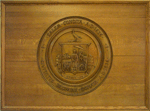Good, Sarah: Difference between revisions
No edit summary |
|||
| Line 20: | Line 20: | ||
[http://salem.noblenet.org/eg/opac/record/2182674?locg=63 Salem possessed; the social origins of witchcraft by Paul Boyer and Stephen Nissenbau] 1974. | [http://salem.noblenet.org/eg/opac/record/2182674?locg=63 Salem possessed; the social origins of witchcraft by Paul Boyer and Stephen Nissenbau] 1974. | ||
"The Untold story of Dorothy Good, Salem's youngest accused witch" by Rachel Christ-Doane. "American Ancestors" magazine, Spring 2023, p. 20-24 | |||
Revision as of 11:12, 3 May 2023
Sarah Good was born to a prosperous innkeeper in 1653. However, her father's estate became entangled in litigation leaving
Sarah Good in poverty. After the death of her first husband, she married William Good. The Goods lived a life of begging and
poverty in Salem Village. Sarah was regarded as an unsavory person and has come to be regarded through literature as the
stereotypical witch, a disreputable old hag. Good was among the first three women accused of witchcraft in 1692 and was the first
to testify.She never confessed guilt, but, like Tituba, she did accuse Sarah Osborne, an act that was credited with validating the
witchcraft trials and accusations. Good was hanged as a witch on Tuesday July 19, 1692, but not until after the imprisonment of
her six year old child Dorcas, also accused of witchcraft, and the tragic death of her infant in prison.
See Also
Important Persons in the Salem Court Records Salem Witch Trials, Univ. of Virginia
Salem possessed; the social origins of witchcraft by Paul Boyer and Stephen Nissenbau 1974.
"The Untold story of Dorothy Good, Salem's youngest accused witch" by Rachel Christ-Doane. "American Ancestors" magazine, Spring 2023, p. 20-24
